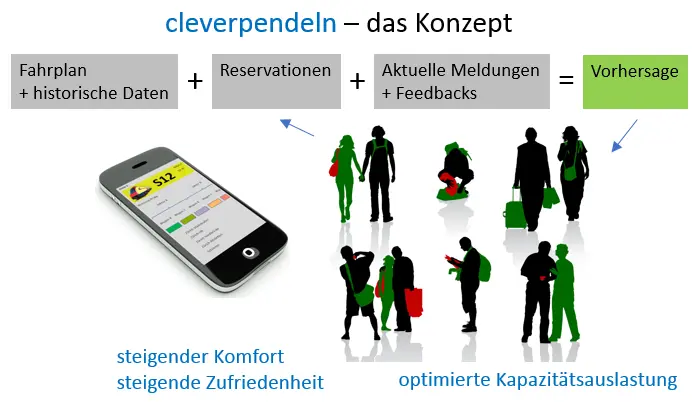cleverpendeln – Personalized Travel Recommendations for Optimized Capacity Utilization & Traffic Management
Increasing commuter flows in rail transport require optimal management of passenger flows. In this project, a system was developed that provides carriage-specific information about train occupancy.

Since the year 2000, commuter flows have increased by 30%, with a further rise of 25% projected by 2040 (Source: ARE, BFS). This poses significant challenges for operators of public transport infrastructure. Many passengers during peak hours in the mornings and evenings complain about not finding any seats and attribute their negative travel experience to the growing demand.
From the operators' perspective, however, there are often still free seats available, for example, at the front and rear ends of trains. For commuters, the problem is that they often barely manage to catch their train on time and therefore board the nearest possible carriage. They do not have the time to look for a carriage with free seats.
With increasing demand, operators of public or private transport infrastructure are compelled to achieve short-term capacity improvements. However, the capacity of the infrastructure is limited (train density), and investments in rolling stock only take effect in the medium to long term due to long procurement cycles. The conclusion: the utilization of the existing infrastructure must be optimized.
Optimization of infrastructure can include, on the one hand, the optimized use of existing capacities, and on the other hand, improved management of passenger flows through better real-time customer information to enhance the efficiency of the available rolling stock. Better distribution of passengers within a train leads to more efficient use of carriages and, under certain conditions, savings in rolling stock. The reduction in rolling stock improves ecological sustainability.
In the research project cleverpendeln (KTI/InnoSuisse 2015-2017), the Institute of Data Analysis and Process Design (IDP), together with the initiator of the described approach and project partner one2seven GmbH, aimed to develop a methodology that provides carriage-specific predictions of train occupancy. Models based on data science and machine learning were to be developed.
In this project, we successfully achieved the core objective of providing highly accurate carriage-specific occupancy forecasts for trains. The developed prediction models utilize current and historical occupancy data as well as employee feedback, combining these information sources. On the one hand, they provide commuters with information about seat availability to improve their travel comfort. On the other hand, they help to better distribute passengers throughout the train, resulting in a more balanced occupancy of individual carriages.
Unlike conventional occupancy displays for entire train services that do not specify individual carriages, we use statistical machine learning models for the forecasts. These models leverage the mentioned data sources and enable very high prediction accuracy and automation. Additional data (from transport operators or third parties) can easily be integrated.
In the future, the model can also be extended to other areas where the optimization of existing capacity utilization must be coordinated with essentially uncontrollable demand — for example, in the operation of railways, roads, airports, or parking facilities.